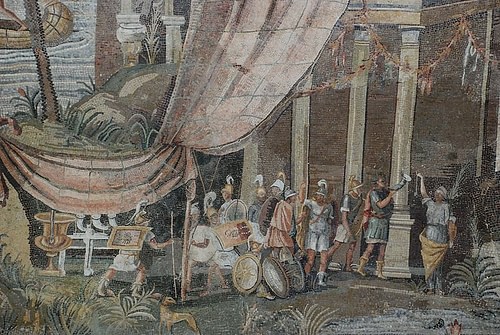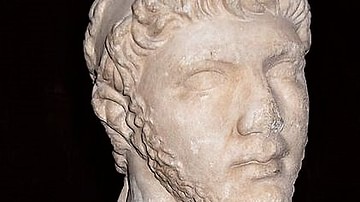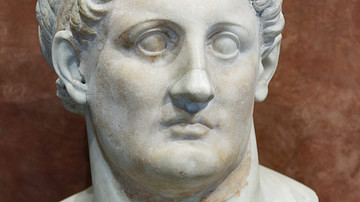
The army of Ptolemaic Egypt was a well-organized fighting force trained in Hellenistic warfare. The Ptolemaic dynasty used their considerable wealth to maintain a large standing army of professional soldiers. Some troops were paid in money, and others were given farmland in exchange for service. In wartime, military expenditure could represent more than three-quarters of national spending.
The Ptolemaic army's earliest members were mostly foreigners who immigrated to Egypt to serve the Ptolemaic dynasty. These soldiers and their descendants established Greek, Persian, Thracian, and Jewish communities in Egypt. Over time, their numbers were replenished by Egyptian conscripts trained in Greek tactics.
Origin, Recruitment & Ethnic Composition
Alexander the Great (r. 336-323 BCE) conquered Egypt in 332 BCE as part of his conquest of the Achaemenid Empire. After the death of Alexander the Great, his general Ptolemy I made himself king of Egypt. Other parts of Alexander's empire were divided between the rest of his generals in the Wars of the Diadochi. The army of Ptolemy I was originally composed of 4,000 soldiers left in Egypt by Alexander, along with thousands of mercenaries.
In Asia, of those who had shared in the division of the satrapies, Ptolemy took over Egypt without difficulty and was treating the inhabitants with kindness. Finding eight thousand talents in the treasury, he began to collect mercenaries and to form an army. A multitude of friends also gathered about him on account of his fairness.
(Diodorus Siculus, 18.14.1)
The core of Ptolemy I's original army was Macedonian. Persian and Egyptian troops left over from before Alexander's conquest were absorbed into this army. As the Hellenistic kingdoms waged perennial territorial wars with each other, they replenished their armies with large numbers of soldiers and mercenaries. Seasoned, professional soldiers had an advantage over new conscripts, and could command high wages.
In terms of bargaining power, soldiers were in a strong position vis-a-vis the rulers, since the latter were in a harsh competition for resources and territory in the decades following Alexander's conquest. Each ruler needed both to hire well-trained soldiers and to prevent his rivals from hiring them.
(Fischer-Bovet, 167)
Ptolemaic recruiting officers (xenologoi) traveled throughout the eastern Mediterranean to enlist mercenaries, and captured enemy troops were also sometimes conscripted. After the Battle of Gaza in 312 BCE, 8,000 prisoners of war were sent back to Egypt and given plots of land in exchange for service. However, the surviving evidence indicates that most recruits traveled to Egypt on their own initiative, either by themselves or in small groups. These people were drawn by Egypt's wealth and the possibility of becoming landowners or ranking officials in the Ptolemaic government. From the 3rd century BCE onwards, new recruits were increasingly conscripted from within Ptolemaic territory. These troops were raised in Greece, Cyrene, Egypt, Cyprus and Syria.
Most recruits in the early Ptolemaic army were from Macedon and mainland Greece. Significant numbers of Thracians, Carians, Persians, and Jews served as well, particularly in the cavalry. The descendants of these troops typically continued to serve as soldiers. Egyptians were another major component of the Ptolemaic army, especially in later periods when they were conscripted en masse. The exact ethnic composition of the Ptolemaic army is unknown because ethnic names were sometimes used to denote rank or language instead of ancestral origin. Galatians and Nubians also served in more limited numbers.
Units & Rank
The highest-ranking military officials were the strategoi, or generals. They typically came from aristocratic families and answered directly to the reigning monarch. Some strategoi commanded armies while others primarily governed provinces and colonies in the Ptolemaic Empire. The eponymous officers commanded both infantry and cavalry, although historians do not agree on whether they were above or subordinate to the strategoi.
Throughout Ptolemaic history, the general equipment, training, and organization of the Ptolemaic forces remained similar to that used by the army of Alexander the Great and his father Philip II of Macedon. Its heavy infantry fought in phalanx formation, using closely packed lines of infantry with long pikes (called a sarissa) and overlapping shields.
There were three primary types of infantry: hoplites and peltasts, who combined as part of a Macedonian phalanx, and light infantry, who were typically mercenaries. The infantry was divided into chiliarchies, of about 1,000 men. Each chiliarchy was divided into smaller units. Officers in charge of chiliarchies or the subdivisions were often given the title hegemon, or commander.
Machimoi were lower-ranking infantry often used as guards and auxiliaries. The majority of machimoi were ethnic Egyptians. They were one of the primary organizations in charge of law enforcement in Ptolemaic Egypt but were also used in foreign wars. The machimoi were said to have played a major role in the Great Revolt of 206 BCE when Upper Egypt attempted to secede from the Ptolemaic Kingdom.
The cavalry was divided into hipparchies of 400-500 men, commanded by a hipparch, who was equivalent to a hegemon. Each hipparchy was further divided into smaller squadrons. Over time, the hipparchies were given individual names or numbers to distinguish them from other units.
There were three main units of elite troops: the agema, the royal guard, and the cavalry of the guard. The agema was a force of 3,000 elite cavalry and infantry equipped as hypaspists, who were divided into three chiliarchies. The royal guard was a mixture of elite troops who guarded the king and his court. Their highest-ranking officers were the somatophylakes, bodyguards who doubled as military advisors to the king. On occasion, the royal guard started coups and riots in Alexandria, such as the mob riot of 203 BCE. The cavalry of the guard was an elite heavy cavalry unit of 700 men, garrisoned in Alexandria.
The most iconic animal unit of the Ptolemaic army was the war elephant. Their impressive size and strength made them sought after as symbols of terror and royal power. The Ptolemaic army had mixed results deploying them in actual combat. The African bush elephants used by the Ptolemies were smaller and less courageous than the Indian elephants used by the Seleucids, and the Ptolemaic army eventually stopped using elephants altogether.
Armour, Weaponry, & Equipment
The Ptolemaic army was trained and outfitted in the Hellenistic style. Equipment was not standardized, but the basic gear used by soldiers was often fairly consistent. The government would often provide equipment to their troops or compensate soldiers for the money they spent on equipment. Horses were provided to cavalrymen at government expense, and stables and veterinarians were established to care for these horses.
Soldiers typically wore a tunic along with a cloak and sturdy boots. Not all soldiers were armored, but those who were carried a breastplate and helmet. Ptolemaic-era breastplates could be made out of iron, bronze, or linen. Linen breastplates were flexible and considerably lighter than metal ones but were still strong enough to protect wearers. The Phrygian conical helmet was the most commonly used style. It did not have a nose guard and usually did not have cheek guards either, which improved visibility at the cost of facial protection. While hoplites carried round shields, some light cavalry carried oval shields in the Celtic style.

Officers were distinguished by colorfully dyed cloaks and plumed helmets. Hellenistic and Roman-era frescoes portray Ptolemaic soldiers with red or yellow cloaks to signify their rank. The cavalry of the guard was equipped with more protective Thracian or Boeotian-style helmets and yellow cloaks with a purple border.
Hoplites were the heavy infantry of the Ptolemaic army, and were kitted with a helmet, breastplate, greaves, and pike (sarissa). They may also have carried a curved sword as a secondary weapon for close-quarters combat. While Classical-era peltasts carried light equipment including wicker shields and javelins, Hellenistic peltasts carried equipment more similar to hoplites. They had smaller shields and javelins, in addition to their heavy gear.
The typical kit of a Ptolemaic heavy cavalryman included a breastplate, a helmet, a belt, and a cloak. They usually carried two spears and a single-edged curved sword. Light cavalry were often unarmored and carried lighter weaponry. Cavalrymen also had to ensure that they had riding equipment including saddles, bridles, reins, and muzzles for themselves.
Wages & Military budget
The Ptolemaic army contained cleruchs or settler soldiers, professional soldiers, and mercenaries. Both professional soldiers and mercenaries in Ptolemaic Egypt received payment in the form of money and food, but professionals resided permanently in Egypt while mercenaries were considered foreigners.
The average wage of soldiers in Ptolemaic Egypt has been estimated at approximately one silver drachma per day, including the cost of their food. Rank-and-file soldiers would have earned less than this, while higher-ranking troops earned more. Cavalry might have earned two drachmas per day while officers would be paid several times more than a rank-and-file soldier. On top of this, enemy soldiers and officers were sometimes offered high premiums to defect. Some soldiers defected from the cause of Perdiccas after his invasion of Egypt in 320 BCE failed.
The Ptolemaic army at the Battle of Raphia in 217 BCE numbered around 70,000 men, including 11,000 mercenaries and 20,000 machimoi. Historian Christelle Fischer-Bovet estimated that the land army of Ptolemaic Egypt in the late 3rd century BCE might have numbered between 50,000 and 55,000 men in peacetime. In wartime, these numbers might have expanded to between 89,000 and 94,000 men.
The annual cost of maintaining the army and navy of Ptolemaic Egypt has been estimated at around 4,500-5,700 talents of silver (34% of the national budget) in peacetime and 10,200-13,400 talents (78% of the budget) in wartime. When not at war, these forces were used to patrol Ptolemaic territory, guard property, and man garrisons.
Cleruchic System
Ptolemaic Egypt is known for instituting a system of land grants whereby the government gave plots of farmland (kleroi) to certain soldiers as payment for their service. These soldiers were often referred to as kleruchoi, or cleruchs, and made up the majority of the Ptolemaic army. The practice of compensating soldiers with land had a long history in both ancient Egypt and Classical Greece. Giving soldiers their own farmland with which to make a living meant that rulers did not need to pay them year-round to maintain a standing army. It also allowed them to distribute the army throughout the countryside, making rebellion less likely. The Ptolemaic cleruchic system was much larger in scale than any of these prior examples.

The Ptolemaic system is thought to have been established under Ptolemy I as a way to ensure the loyalty of his army, who might otherwise have defected to one of his enemies. In peacetime, cleruchs were only mobilized part of the year for patrols and garrisons, during which they received pay. They were off duty for the rest of the year, acting as reserves. This created a land-owning class of settler soldiers with a vested interest in supporting a Greek regime. These cleruchs helped to accelerate the process of Hellenization, whereby Egyptian society was influenced by Greek culture. Ethnic Egyptian cleruchs typically learned Greek so that they could more easily advance in a Greek-speaking hierarchy, and many of them also took Greek names.
There is at least some sense in which the military settlements helped the Ptolemies occupy and colonize Egypt: the settlers were usually more affluent – often far more – than the Egyptians who dwelt around them, were often better connected to administrative and legal authorities, and as military men constantly represented the potential repressive power of the Ptolemaic state and their own potential for intimidation or violence. (Johstono, 267)
The amount of land given to each soldier was determined by his rank and status. The standard unit of measuring this land was the aroura, which was equivalent to 2,025 square meters. Machimoi received smaller plots between 5 and 20 arouras, enough to help support a small family. Infantrymen received between 16 and 30 arouras. Cavalry could expect to receive between 70 and 100 arouras of land, which was enough to generate a sizable profit if all of it was cultivated. Many high-ranking officers leased their land out to tenant farmers and bought townhouses in the city for themselves to live in.
Under the early Ptolemies, a cleruch only held onto his land for the duration of his life, and ownership reverted to the government after he died. Sons often followed their fathers into military service and were given comparable plots of land. In later generations, this system evolved to allow cleruchs to leave their land to their families after they died.









